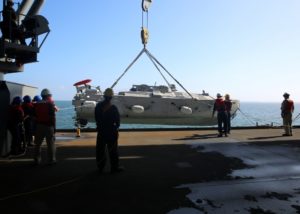The Navy is planning to conduct an expeditionary sea base (ESB) Phase III feasibility demonstration of the Littoral Combat Ship (LCS) mine countermeasures (MCM) mission package in the spring.
In September, the Navy successfully tested the LCS MCM mission package from the USNS Hershel “Woody” Williams (T-ESB-4) while operating in the Chesapeake Bay. That test had the ship test the MCM mission package portable control station to maneuver MCM equipment as well as launch and recover the pieces (Defense Daily, Sept. 23).

The ESB tests are an effort to prove they can operate as a vessel of opportunity (VOO) for the LCS MCM mission packages, expanding their utility beyond LCSs.
Speaking during the annual Surface Navy Association symposium on Jan. 16, Capt. Gus Weekes, Mission Modules program manager, underscored that unlike the September test, the upcoming April Phase III test will include aviation assets for the first time on a VOO.
After the Chief of Naval Operations two years ago said the service needed to look at deploying MCM from VOOs, the Navy is now “going to do Phase III of that in April or May of this year, proving out the ability to take the MCM mission package on a vessel of opportunity,” Weekes said.
By adding the aviation element and the full package, the Navy is “very excited about that ability, to possibly prove out that capability,” Weekes added.
All aviation MCM mission modules are currently certified to deploy on Independence-variant LCSs while testing and certification for the Freedom-variant is expected to be complete by the second quarter of FY 2020.
The Navy plans to conduct the full MCM mission package developmental/operational testing in FY 2021 and reach initial operating capability in FY 2022.
Last June, Capt. Scot Searles, Strategic and Theater Sealift Program Manager at PEO Ships, first said the Navy planned to experiment putting the LCS MCM mission package on expeditionary sea bases as possible VOOs (Defense Daily, June 19, 2019).
Searles noted the ESBs are prewired for the kinds of interfaces that can work with MCM containers and is large enough to carry one or two packages.
Weekes underscored the MCM mission packages are very heavy and require a crane, station to launch systems, and the right power and communications interfaces for the portable control station.
The MCM mission package is meant to replace the legacy Avenger-class MCM ships and MH-53E helicopters, which are set to expire in the near future. The MCM capabilities are planned to most be used on LCS but is reserving some for use on VOOs.
The LCS MCM systems include the Textron [TXT] Common Unmanned Surface Vessel (CUSV) that tows systems like the unmanned surface sweep system and Raytheon [RTN] AQS-20 mine hunting sonar, General Dynamics’ [GD] Knifefish surface mine countermeasure unmanned underwater vehicle, Sikorsky [LMT] MH-60 helicopters equipped with the Northrop Grumman [NOC] AN/AES-1 Airborne Laser Mine Detection System (ALMDS) and Raytheon AN/ASQ-235 Airborne Mine Neutralization Systems (AMNS), and the Northrop Grumman MQ-8B Firescout unmanned helicopter.